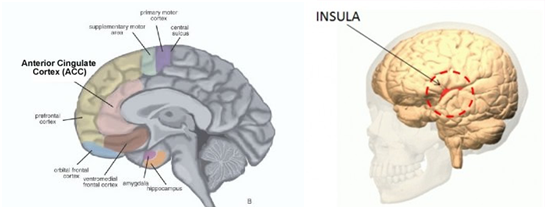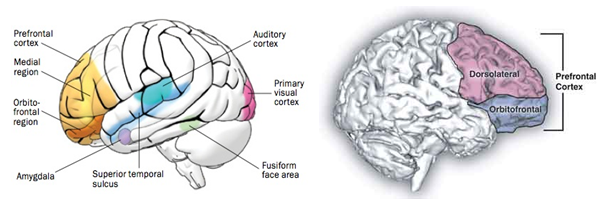What does brain do most of the times? Marco Lacoboni, a discoverer of mirror neurons (we will soon see what they are), and Mathew Lieberman, a founder of social neuroscience, discovered that when nothing much is going on, the brain’s default activity is to mull over our relationships. Yes! It is its favorite downtime act. And in fact, this ‘people’ circuit only quiets down when brain turns to any impersonal activity like checking a text for grammatical mistakes.
Well! Studies say that even while the rest of the brain is quiet, four neural areas remain active – ever ready for a quick response. And incidentally, three of these four areas are involved in observing and judging people. And these neural zones automatically increase their activity when we think about or watch any people interact. Yes! The immense need of interdependence in environ in which humans have lived over last few million years has resulted into special importance given to the social-interfacing in our brain’s design.
So there is a certain ‘social brain’ all of us have. Well! No neuroscientist would be amused by this phrase because the fact is that no function in brain can be localized to certain organs or circuitry. Still, there are a few areas in the brain that are most actively involved in the ‘people & relationships’ centric functions and thus can be considered as the ones forming our conceptual ‘social brain’. They are Amygdala, Hippocampus, Brainstem, Insula, Prefrontal Cortex (PFC), Orbito-Frontal Cortex (OFC), Anterior Cingulate Cortex (ACC), Ventromedial Cortex (VMC) and Premotor Cortex.

While we have already discussed about brainstem, amygdala and hippocampus, let’s briefly know something about the rest of them:
Insula, due to its location, is normally considered to be a limbic-related organ. Its functions include perception, self-awareness, cognitive functioning and interpersonal experience. To be more precise, it processes a person’s sense of disgust and is also involved in the emotional processing specifically related to empathy and norm-violation.
Prefrontal Cortex is located in the front portion of the frontal lobe. It has been implicated in planning complex cognitive responses, decision making, and moderating social behavior. It orchestrates thoughts and actions in accordance with internal or defined goals. Thus, it is involved in handling conflicting thoughts, determining future consequences of current activities, regulating the expectations based on actions, and producing socially acceptable outcomes in a given situation.
Orbito-Frontal Cortex (OFC) is positioned immediately above the orbits in which the eyes are located. The human OFC is among the least-understood regions of the human brain but it is believed to be involved in a unique work of representing both emotion and reward in the evaluation of making a decision. It also compares the expected reward/punishment with the actual reward/punishment and thus, is critical for adaptive learning. It also aids in detecting the nonverbal signals of emotions, deciding its emotional significance and then factoring in those inputs into making a cognitive decision.
Anterior Cingulate Cortex (ACC) is also in frontal lobe and is involved in both executive tasks and emotional functions. It is involved in rational cognitive functions like reward anticipation, decision making, error detection and conflict monitoring and impulse control. However, it is also involved in human consciousness and emotional awareness. It aids recognition of emotional cues and in empathy. It is also the cortical area that has been most frequently linked to the experience of pain.
Ventromedial Cortex (VMC) is also a part of frontal lobe and is involved in inhibition of emotional responses in the process of decision making. Neural networks in the ventromedial prefrontal cortex develop rapidly during adolescence and young adulthood supporting emotion regulation. It aids in processing fear & risk, detecting irony, sarcasm, and deception and in abiding by morals. It also plays a role in social emotions like compassion, shame and guilt.
Premotor Cortex also lies in frontal lobe. It plays a role in the direct control of behavior. It is also involved in planning movement, in the sensory & spatial guidance of movement, in using abstract rules to perform specific tasks and most importantly in understanding the actions of others.
All these areas are helped by many others. Auditory cortex and visual cortex bring the sensory information, fusiform area detects face and the medial prefrontal cortex and superior temporal sulcus read the mood of a person through the emotional clues in the nonverbal signals. So, the social brain is a concept that goes beyond just a few brain areas, yet now you know the major ones.
So, what would typically be the neural reality of our interpersonal interactions?
When it comes to the neural activity in interpersonal interactions then we are not talking about a single neural system but rather interlocking circuits that can work together for some tasks and on their own for others. The more complicated a social interaction, the more complex the interconnected networks of neurons activated. Let’s try to understand some of them through an illustration by Daniel Goleman:

During the conversation, we have to stay attentive and monitor the other person by picking up subtlest of cues of facial expressions and other nonverbal social prompts. The ancient structures in the brainstem – particularly the cerebellum and basal ganglia – take care of that. During the conversation, our autonomic responses (like increase in our heart-rate) are controlled by the connections from amygdala to brainstem.
Recognizing and reading emotions on the other person’s face or monitoring shift in person’s gaze is done by the neurons in the fusiform area of the temporal lobe. Sensing the other person’s mental state or keeping track of our own responses is attributed to the somatosensory areas of the brain. Moreover, sending emotional messages back through a smile, frown or an expression like ‘raised eyebrows’ is through the nuclei projections from brainstem to our facial nerves.
How do we form the mental images that spring to mind when we talk with someone about something we are both familiar with? Mirror neurons in the prefrontal cortex of parietal areas handle these shared representations. When we simply observe someone else’s actions then the other mirror neurons involved in movement get activated. And when we coordinate our own movements in response to the other person then it is the job of neurons in the right parietal operculum that encode the sensory and kinesthetic (related to gestures) feedback.
When it comes to reading and responding to the emotional cues in someone’s tone of voice then it is the set of mirror-neurons priming circuitry that connects the insula and premotor cortex with the limbic system areas (particularly amygdala). When it comes to specific emotions, further distinctions are possible:
Fearful expressions seem to light up the amygdala, as with fear, our attentions goes to what has caused the fear. Angry ones activate the OFC and not the amygdala because we focus on what to do to reverse that person’s reaction. And when it comes to disgust, the insula and basal ganglia come into play. These circuits activate both when we experience and witness the emotions.
While we attune to the other person, the brain undergoes two varieties of empathy – emotional and cognitive. Emotional empathy takes the route of fast emotional-subway (we will get introduced to it soon) via connections between the sensory cortices and the lower areas of the brain like thalamus and amygdala. This emotional empathy is primed to react instinctively, because it emerges out of automatic neural mimicking of other’s feelings.
Cognitive empathy takes the route of slower high-road (we will get introduced to it soon) that runs from the thalamus up to the neocortex and then down to the amygdala and on to our more thought-through responses. This cognitive empathy offers a more logical empathy – one that is possible to be shut down if we choose to.
When we have to think over what to make of the other person’s emotional messages then the dorsolateral and ventromedial prefrontal regions help us judge what it all means and consider our alternatives keeping in mind both the short-term and the long-term goals.
Moreover, there are times when we get troubled or offended by something in other person’s emotions yet remain focused despite our upset. This is attributed to the connections from the limbic areas to the Orbitofrontal cortex (OFC) & Anterior Cingulate Cortex (ACC). These areas are active in fine-tuning our emotional responses, making them more apt to the situation. These areas and, in general, prefrontal cortex (PFC) has the task of modulating our emotions in ways that are appropriate and effective.
Well! All these interactions explained above will start making more sense to you later, in the light of coming knowledge. But this whole text is important for a realization that every emotional-act of ours is regulated by some or other part of the brain.
